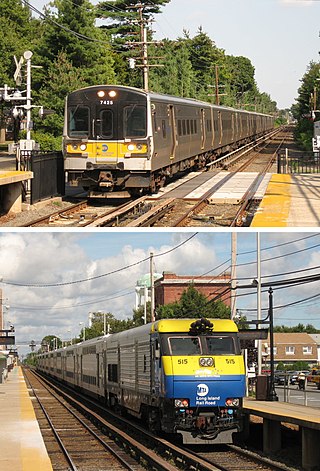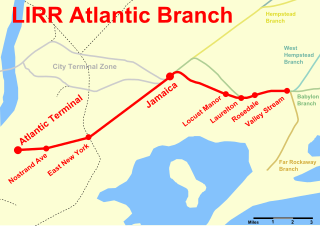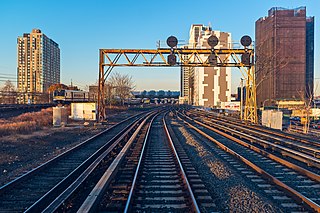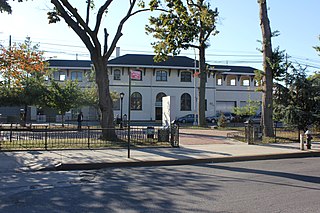
The Long Island Rail Road, often abbreviated as the LIRR, is a railroad in the southeastern part of the U.S. state of New York, stretching from Manhattan to the eastern tip of Suffolk County on Long Island. The railroad currently operates a public commuter rail service, with its freight operations contracted to the New York and Atlantic Railway. With an average weekday ridership of 354,800 passengers in 2016, it is the busiest commuter railroad in North America. It is also one of the world's few commuter systems that runs 24/7 year-round. It is publicly owned by the Metropolitan Transportation Authority, which refers to it as MTA Long Island Rail Road. In 2023, the system had a ridership of 75,186,900, or about 253,800 per weekday as of the fourth quarter of 2023.

The Atlantic Branch is an electrified rail line owned and operated by the Long Island Rail Road in the U.S. state of New York. It is the only LIRR line with revenue passenger service in the borough of Brooklyn.

Little Neck is a station on the Long Island Rail Road's Port Washington Branch in the Little Neck neighborhood of Queens, New York City. The station is at Little Neck Parkway and 39th Road, about half a mile north of Northern Boulevard. Little Neck station is 14.5 miles (23.3 km) from Penn Station in Midtown Manhattan, and is the easternmost station on the Port Washington Branch in New York City. The station house is located on the south (eastbound) side, unlike most station houses on the Port Washington Branch. The station is part of the CityTicket program and is in Zone 3.

The Montauk Branch is a rail line owned and operated by the Long Island Rail Road in the U.S. state of New York. The line runs the length of Long Island, 115 miles (185 km) from Long Island City to Montauk. However, in LIRR maps and schedules for public use, the term Montauk Branch refers to the line east of Babylon; service from Jamaica to Babylon is covered by separate Babylon Branch schedules, while the line west of Jamaica is currently unused for passenger service. A select number of Montauk Branch trains operate via the Main Line during peak hours.

The Main Line is a rail line owned and operated by the Long Island Rail Road in the U.S. state of New York. It begins as a two-track line at Long Island City station in Long Island City, Queens, and runs along the middle of Long Island about 95 miles (153 km) to Greenport station in Greenport, Suffolk County. At Harold Interlocking approximately one mile east of Long Island City, the tracks from the East River Tunnels and 63rd Street Tunnel into Manhattan intersect with the Main Line, which most trains use rather than using the Long Island City station.
The South Side Railroad of Long Island was a railroad company in the U.S. state of New York. Chartered in 1860 and first opened in 1867 as a competitor to the Long Island Rail Road, it was reorganized in 1874 as the Southern Railroad of Long Island and leased in 1876 to the LIRR. After a reorganization as the Brooklyn and Montauk Railroad in 1879 it was merged in 1889.
The Manhattan Beach Branch, Manhattan Beach Line, or Manhattan Beach Division was a line of the Long Island Rail Road, running from Fresh Pond, Queens, south to Manhattan Beach, Brooklyn, New York City, United States. It opened in 1877 and 1878 as the main line of the New York and Manhattan Beach Railway. The tracks from Flatbush south to Manhattan Beach were removed from 1938 to 1941, while most of the rest is now the freight-only Bay Ridge Branch.
The Long Island Rail Road is a railroad owned by the Metropolitan Transportation Authority in the U.S. state of New York. It is the oldest United States railroad still operating under its original name and charter. It consolidated several other companies in the late 19th century. The Pennsylvania Railroad owned the Long Island Rail Road for the majority of the 20th century and sold it to the State in 1966.

Dunton was a ground-level station on the Long Island Rail Road's Montauk Branch, Atlantic Branch, and later the Main Line in Dunton, Queens, New York City, United States. It was closed in 1939 when the Atlantic Branch was placed in a tunnel east of East New York.

Springfield Junction was a junction between the Long Island Rail Road's Montauk Branch and Atlantic Branch in Laurelton, Queens, New York City, United States. It was located at the place where those two branches now begin to parallel, just east of Laurelton station and half a mile east of Springfield Boulevard. No rail station was located at the junction itself, however Springfield Gardens station was located nearby.

Rockaway Junction was a junction and station on the Long Island Rail Road's Main Line and Montauk Branch in Hillside, Queens, New York City, United States. It was located in the vicinity where the Montauk Branch now crosses over the two eastbound passenger tracks and the two freight tracks of the Main Line, just west of the Hillside Facility, although at the time of the station's existence it was at ground level along with the junction itself.

Queens Village is a station on the Long Island Rail Road's Main Line, located between 218th Street and Springfield Boulevard, in the Queens Village neighborhood of Queens, New York City. It has two side platforms along the four-track line, and is served primarily by Hempstead Branch trains. Just east of the station is Queens Interlocking, a universal interlocking that splits the four-track line into two parallel two-track lines—the Main Line and Hempstead Branch—and controls the junction with the spur to Belmont Park. The station is elevated and the tracks leading in and out are on raised ground and only above the road at intersections.

Fresh Pond was a small middle class neighborhood in the New York City borough of Queens, separated from Juniper Valley by the Lutheran and Mount Olivet cemeteries. In present day, it is now considered part of the surrounding neighborhoods of Maspeth, Middle Village, Glendale, and Ridgewood and is no longer referred to by the name "Fresh Pond." The area was originally named for two freshwater ponds that, in the early 1900s, were filled in. Other ponds were lower, and brackish due to Newtown Creek being estuarine.
The Creedmoor Branch was the name of a short branch that the Long Island Rail Road gave to the right of way of tracks between its Floral Park station and Creedmoor State Hospital in Queens, New York. The branch existed from 1879 to 1966 finally being torn up and demapped in the early 1970s.
The Garden City–Mitchell Field Secondary is a lightly used freight branch of the Long Island Rail Road. It is a spur off the Hempstead Branch.

The Evergreen Branch was a branch of the Long Island Rail Road (LIRR) that ran in Brooklyn and part of Queens in New York City. The line, at its fullest extent, ran between Greenpoint, Brooklyn and Ridgewood, Queens. The line consisted of two leased portions. The first portion, between Greenpoint and Jefferson Street, was leased from the Glendale and East River Railroad. The second portion, from Jefferson Street to Ridgewood, was leased from the Brooklyn and Rockaway Beach Railroad Company, and was known as the Evergreen Branch, a name later extended to the rest of the line.
Central Railroad of Long Island was built on Long Island, New York, by Alexander Turney Stewart, who was also the founder of Garden City. The railroad was established in 1871, then merged with the Flushing and North Side Railroad in 1874 to form the Flushing, North Shore and Central Railroad. It was finally acquired by the Long Island Rail Road in 1876 and divided into separate branches. Despite its short existence, the CRRLI had a major impact on railroading and development on Long Island.

Glendale was a Long Island Rail Road station along the Lower Montauk Branch, located in Glendale, Queens at Edsall Avenue and 73rd Street, near Central Avenue, at the All Faiths Monuments factory for the All Faiths Cemetery. This station had two "platforms" which were just strips of pavement besides the tracks signed as the station, and two tracks.

The Flushing and North Side Railroad was a former railroad on Long Island built by Conrad Poppenhusen as a replacement for the former New York and Flushing Railroad. The railroad was established in 1868, was merged with the Central Railroad of Long Island in 1874 to form the Flushing, North Shore and Central Railroad, and was finally acquired by the Long Island Rail Road in 1876. Today the main line is known as the Port Washington Branch of the Long Island Rail Road.
Bushwick, also known as Bushwick Terminal, was a train station along the Bushwick Branch, and terminal of the Bushwick Branch of the Long Island Rail Road from February 29, 1876, to May 13, 1924. Bushwick Terminal was located at Montrose Avenue and Bushwick Avenue in East Williamsburg, Brooklyn. It opened on July 18, 1868, and closed in 1924 with the end of passenger service on the Bushwick Branch. Steam engines served the station until 1913. The station building made in brick survived until recently and was the last vestige of the passenger terminal of the Bushwick Branch. Before it was demolished, the building was used as an automobile repair shop. The terminal building was replaced by a building that was in the process of being built in October 2007, and holds trucks.


















